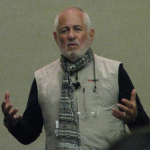The following is my attempt to transcribe Richard Saul Wurman’s comments, but I recommend listening to the 6 minute recording to get the full effect:
I don’t understand everything that people say. I had to ask what a wireframe was. I don’t know what a wireframe is because I don’t think in terms of wireframes… I don’t think in terms of information architecture; I think in terms of understanding. I’m interested in understanding things that interest me. And I’m interested in the rigor, a systemic rigor, of being able to explain…
Ultimately it’s not the modality, it’s not the wireframe or computer. The first books I did were in 1962 when I did maps of 50 cities in the world to the same scale. I thought that was information architecture — it had a rigor about explaining something. Computers weren’t around then…
With what just came out now, the iPad, you’re not going to be doing “screens”. Everything is going to be, on that machine, is going to be a movie. It’s going to be a continuum of flying through understanding. The old Muriel Cooper flying through information idea that was presented at TED. TED was another thing that I was involved in…
Don’t you want to just try to figure out, at any moment in history, how to explain something to somebody else, to another human being, with whatever tools happen to be around then? But don’t invest in the tool. Invest in your curiosity, and the rigor of your curiosity, and the rigor of your explanation, and being able to explain it to another human being which would be quite different in five years or ten years…
I think the best thing we do is have conversations with each other. I think the best thing I can do is just have a conversation with one other person. Now is that information architecture? Well, if they understand something, and I understand something, and I have rigor to my language, clarity to my language… I don’t say “I go” instead of “I said”. I don’t say “ya know”. I don’t say any of the language that makes us not as clear as we can be. If we’re clear about our language and our imagery, and about the ordering of that, and we give examples that allow each thing that we say to be understood relative to something else… So we make little baby steps from understanding to understanding…
Most of you have heard a very old question I ask people is, “How big is an acre?” And somebody remembers, oh from their junior high school days, it was 43,560 square feet. But then it doesn’t mean anything to somebody else because you can’t understand what 43,560 of anything is! So in context of having a conversation, and you say an acre, you say it’s about the size of an American football field without the endzones. And even if you don’t like football, or play football, you’ve seen in your high school or someplace, a football field, so you now all know what an acre is. It’s about the size of an American football field. That’s information architecture too, because you thought of a rigorous way of explaining something to somebody else. It’s not always the facts that explain something to somebody else…
Bhopal, India: if you say it’s the largest city in central India, which in 1984 they had a terrible, terrible accident with a spill of all the chemicals. If you say it’s the largest city in central India, most people will think it looks like a village because that’s what the photos look like. So the photos lied. And saying it’s the largest city in central India is the truth. But then you think from that statement, because you don’t know another city in central India, that it has millions and millions of people and it only has 600,000. So what I’m interested in is communicating with another person, and I say, Bhopal, which is not only the largest city in central India, but about the size of San Francisco or Boston…
I’m interested in communicating with another human being, whether it’s in a conversation (which is all I can do with a microphone, I can’t do it with these wireframe things, and I don’t have a computer), and I can only do what I can do with this. And this is my modality, my mouth, my voicebox, and this. And I’m communicating to the people in this room. And I’m doing it with rigor and with responsibility. And that’s what information architecture is. Not the modality. Not the particular technology. Not a wireframe. Not an iPad. Not a computer. Not color. Not no color. Millions of colors. Certainly not pie charts. It’s just making yourself understandable, which is what we do as human beings, with memory, which it seems that other animals don’t…
